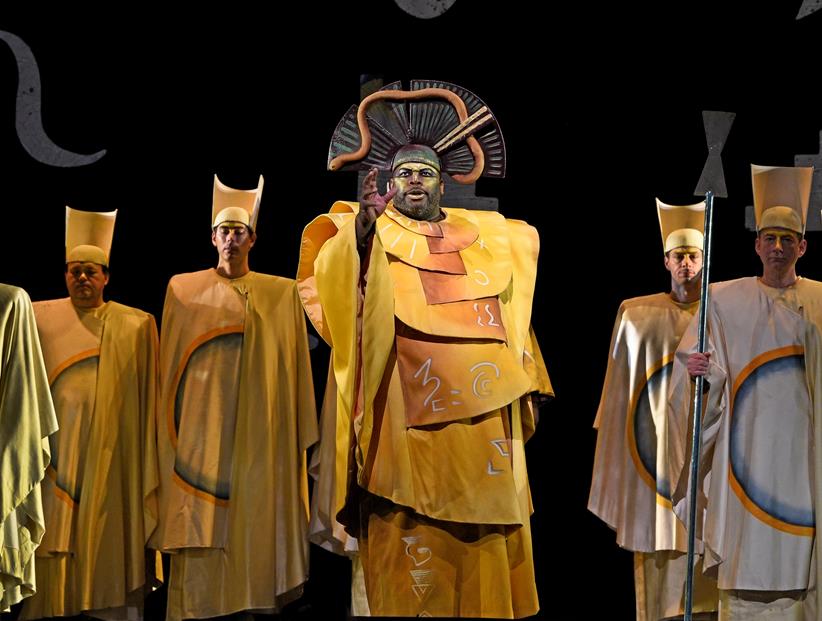Makeup Mismatches

A performer’s onstage appearance ideally should result from a close partnership with a makeup artist. “I am the designer, but the performer has to wear the makeup,” says Cassie Williams, hair and makeup designer at the 2021 Glimmerglass Festival. Well-designed makeup can make an artist feel empowered and comfortable onstage — and enhance the audience’s experience. Unfortunately, that is not always the case when performers who are Black, Indigenous, Asian, and Asian American are involved. Singers of color have long encountered makeup schemes that make it hard for them to “like the way they look” onstage.
Many of the Black singers who broke racial barriers in the 1960s and 1970s, like Leontyne Price, Grace Bumbry, and Reri Grist, suffered the indignity of having to wear heavy white and lightening paints — partly because they were playing “White” characters, and partly because of the inadequacy of stage lighting designed only for White performers. That struggle continues today, as dark-skinned singers encounter makeup artists who have neither the professional
tools nor the skill sets necessary for their faces.
“You’ll sometimes get this look when makeup artists see you, like ‘What am I going to do with this?’” says soprano Nicole Heaston. “And you feel, ‘I’m a burden on this situation. They have to work that much harder for me.’”
Bass Morris Robinson has learned to insist on applying his own makeup. Earlier in his career, he would encounter makeup artists who simply did not know how to deal with his skin tone. “They would use the darkest makeup they had, but that would still make my face look ashy,” he says. “They didn’t have what they needed to accentuate my natural color. Now I just play the character as best I can without their putting makeup on me.”
Even abstract makeup designs with non-human colors like green, silver, or pancake white can pose problems, according to Robinson. “You can’t put a white base on my Black face and expect it to last in front of the lights,” he says. “Let’s go with what God gave me.” At the Met, where he has appeared as Sarastro in five revivals of The Magic Flute, Robinson has worked with the company’s makeup artists to jettison the production’s original all-white makeup scheme and use his own skin color, with colorful accents for his eyes.
Asian and Asian American singers often encounter similar frustrations when dealing with North American and European makeup departments. “They have trouble with our eyes,” says soprano Kathleen Kim. “They want to make them bigger. I think that makes our faces look worse.”
In some cases, wig and makeup departments will try to shoehorn BIPOC singers into a production design, “fixing” them to suit preexisting ideas of a character’s size, skin color, or hair texture. “You’re never going to look like that person they want, no matter how hard they try,” says Heaston. It is far preferable, she says, when the people responsible for wigs, makeup, and costumes have studied the performer they’ll be working with. “You want to come into an environment where you feel wanted and needed, and it makes you more purposeful in your job,” Heaston says.
The craft of designing wigs and makeup for Black artists is hardly a one-size-fits-all situation. “Makeup artists will put makeup on a Black person the same way they put it on the last Black person they worked with, and it may not necessarily work,” says Heaston. “You have to look at the artist.” She mentions a production she stepped into where the wig for previous sopranos had been a soubrette-ish “sweep updo.” Heaston, who wears her hair straight, expected to wear a version of the original hairstyle, but arrived to find she had been given locs: “People want to course-correct — ‘Let’s make her Afrocentric!’”
“Just because an artist is a person of color and we have the same background, I still want to learn,” says Cassie Williams. As she sees it, the job of working with singers requires assiduous study. “It’s not the performers’ job to educate us,” she says. “It’s our job to educate us.”
For Robinson, the shortcomings of opera makeup departments point to inequities within the industry as a whole. “Diversity and inclusion and equity means representation throughout the ranks of the entire company,” he says. “Just like having Black artists onstage, we need artists backstage who can help us bring characters to life. We need diversity there, as well.”
This article was published in the Fall 2021 issue of Opera America Magazine.

Alison Kinney
Alison Kinney is an author, teacher, and nonfiction writer on culture, history, music, and social justice. Her second book, Avidly Reads Opera, was published in fall 2021.




